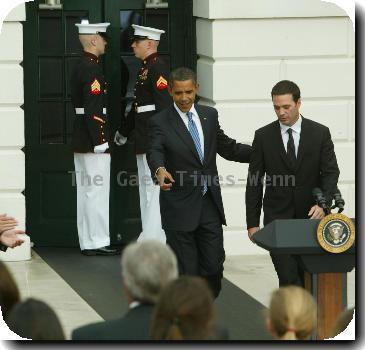AP Poll: Americans support public health plan _ depending on how you ask
By Erica Werner, APWednesday, November 18, 2009
AP Poll: Public favors gov’t health plan
WASHINGTON — More Americans support creation of a new government-run health insurance plan to compete with the private insurance market, a new Associated Press poll finds, but the level of enthusiasm depends on how the question is asked.
Tell people that letting the government sell insurance would be cheaper for them, and a majority is in favor.
Tell them the government would be making decisions about what medical care they could get, and support sinks.
The findings from an Associated Press poll come as lawmakers struggle to advance President Barack Obama’s signature health care overhaul, with the final shape of any government insurance plan very much in doubt. The issue has been the biggest flash point in the health care debate, and the poll results underscore that how it is defined can make a big difference in the public’s response.
Politicians know that. It’s why when Republicans talk about letting the government sell health coverage in competition with private carriers, they cast it as a government takeover that would destroy private industry. Democrats talk about choice, competition and “keeping health insurance companies honest.”
The AP poll, conducted by Stanford University with the Robert Wood Johnson Foundation, suggests that when such messages are heard, they have an effect.
Half of the 1,500 participants in the AP poll were told that a government insurance plan “would be less expensive than other insurance plans, because the government would not need to make a profit the way businesses do and because the government is able to negotiate lower prices with doctors and hospitals than insurance companies can.”
Fifty-two percent said they favored such a plan, while 35 percent were opposed and 12 percent neither favored nor opposed it.
“I fundamentally feel that the private insurance industry basically holds all the market power” and could use some competition from a nonprofit alternative, said Robert Baulch, 58, of North Chatham, Mass.
The goal is “covering a lot of folks that just can’t get coverage and reducing the cost overall,” he said.
The other half of the people polled were told the government plan would be less expensive, but they were also told that “the government would run the insurance plan and decide which medical care would be paid for and how much would be paid, like insurance companies do.”
That version of the question found 44 percent in support and 38 percent opposed, while 15 percent neither favored nor opposed the idea.
“They would decide which medical care would be paid for,” said Jeff Anderson, 43, of Burlingame, Calif. “If you have a tumor growing inside you that needs to be removed or you’re going to die, and they decide, well, we don’t cover cancer or we don’t cover other types of diseases — you know, that’s just wrong.”
So while both questions elicited more supporters than opponents for a public insurance plan — bearing out the results of past polling that has shown the public generally supportive — the plan commanded majority support only when cast in positive terms that emphasized benefits to consumers over government control.
The poll also sought to elicit views of the government insurance plan design under consideration by Senate Majority Leader Harry Reid, D-Nev., as he finalizes a health care bill to bring to the Senate floor.
Legislation passed by the House this month included a public plan available nationally for small businesses and, mostly, self-employed people. Under Reid’s version, individual states would be able to opt out of the public plan.
Poll participants were asked whether government insurance should be available to all, or whether state governments should be able to decide not to offer it. Seventy percent favored making it available nationally while 25 percent said state governments should be able to decide.
Overall, the poll found the public split on Congress’ drive to enact sweeping legislation extending coverage to tens of millions of uninsured Americans. Opinion was also evenly divided on Obama’s handling of the matter, and participants expressed concerns and confusion about costs and various other aspects of the issue.
Despite the controversy surrounding the public plan, it would affect a small number of people. A Congressional Budget Office analysis of the House bill estimated that about 6 million people would sign up for the public option in 2019, once it was fully phased in. That represents about 2 percent of Americans under age 65. (Older people are covered through Medicare.)
The overwhelming majority of the population would remain in private health insurance plans sponsored by employers. Others, mainly low-income people, would be covered through an expanded Medicaid program.
The budget office also said that “a less healthy pool of enrollees” would probably be attracted to the public option, drawn by the prospect of looser rules on access to specialists and medical services. As a result, premiums in the public plan would actually be higher than the average for private plans, according to the budget office.
In the AP-GfK poll, the differently worded questions on the public plan each had a sampling error margin of plus or minus 3.6 percentage points. The poll interviewed 1,502 people from Oct. 29-Nov. 8 with an overall sampling error margin of plus or minus 2.5 percentage points.
The interviews were conducted by GfK Roper Public Affairs & Media. Stanford University’s participation in the project was made possible by a grant from the Robert Wood Johnson Foundation.
AP Polling Director Trevor Tompson and Associated Press writers Ann Sanner and Natasha Metzler contributed to this report.
Tags: Barack Obama, Bills, Health Care Reform, Health Insurance Providers, Insurance, Insurance Industry Regulation, Managed Health Care Providers, North America, Public Opinion, United States, Washington

